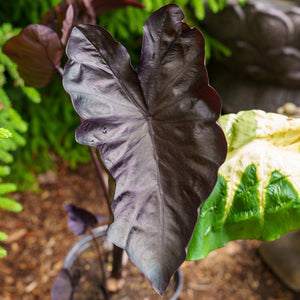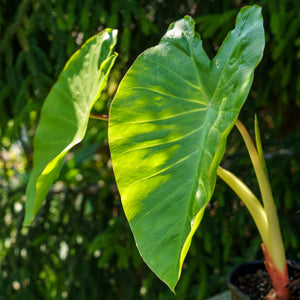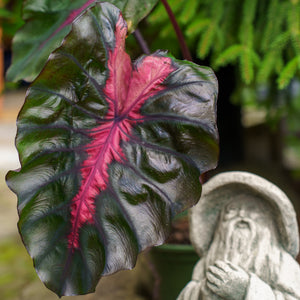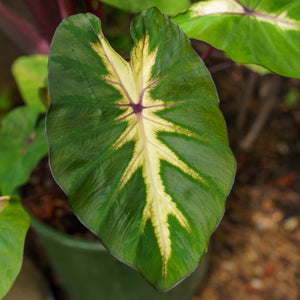The Colocasia Guide
Colocasia, commonly known as elephant ears, is a dramatic foliage plant admired for its massive, heart-shaped leaves and lush, tropical presence. Grown for their striking foliage rather than blooms, Colocasia cultivars come in a variety of colors including green, purple, black, and variegated patterns. These bold plants are perfect for adding height and a tropical feel to garden beds, containers, and water features. Here’s everything you need to know about growing and caring for Colocasia.
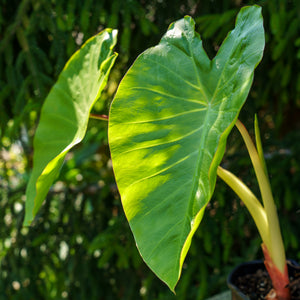
About
Colocasia is a genus in the Araceae family and is native to tropical Asia and Polynesia. The most well-known species is Colocasia esculenta, which includes both ornamental varieties and those cultivated for edible tubers (taro). Colocasia plants are distinguished by their downward-facing, peltate leaves that resemble elephant ears, giving them their common name.
Popular varieties include Colocasia 'Black Beauty', known for its deep, velvety black leaves; Colocasia 'Mojito', with its unique speckled green and purple foliage; Colocasia 'Royal Hawaiian White Lava', a standout with white centers and dark margins; and Colocasia 'Thailand Giant', which boasts truly enormous leaves. Other selections like Colocasia 'Tea Cup', 'Maui Sunrise', and 'Nancy's Revenge' offer striking variations in color, shape, and leaf habit.
Colocasia is an excellent choice for bold container displays, tropical-themed gardens, and pond edges where it can thrive in moist or even wet conditions.
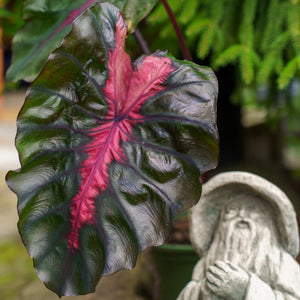
PLANTING
Colocasia is easy to grow if given the warmth and moisture it craves. These plants can be grown outdoors as annuals or perennials depending on your climate, or indoors as dramatic houseplants.
- USDA Hardiness Zones: Perennial in Zones 8–11; grown as annuals or overwintered indoors in cooler regions.
- Soil: Prefers rich, moist, and well-drained soil high in organic matter. Tolerates clay and boggy soils.
- Sunlight: Full sun to part shade. Darker-leaved varieties tend to need more sun to maintain their color.
- Watering: Keep soil consistently moist. Colocasia thrives with regular watering and tolerates wet or even submerged soil conditions.
- Spacing: Space plants 2–4 feet apart depending on the mature size of the variety.
- Planting Time: Plant tubers or young plants after the danger of frost has passed and soil has warmed.
When planting tubers, place them horizontally 2–3 inches deep in well-prepared soil. Water thoroughly and keep the soil warm and moist for best growth.

CARE
With consistent moisture and warmth, Colocasia will reward you with rapid growth and massive, eye-catching foliage throughout the growing season.
- Watering: Keep soil constantly moist. Container-grown plants may require daily watering in hot weather.
- Fertilizing: Feed monthly with a balanced or nitrogen-rich fertilizer to support vigorous leaf growth.
- Mulching: Apply mulch to retain moisture and regulate soil temperature.
- Pruning: Remove any yellowing or damaged leaves at the base. Trim back in fall if overwintering indoors.
- Overwintering: In Zones 7 and colder, dig and store tubers in a dry, cool place or bring container plants indoors.
- Pests & Diseases: Watch for spider mites, aphids, and fungal leaf spots. Maintain good air circulation to prevent disease.
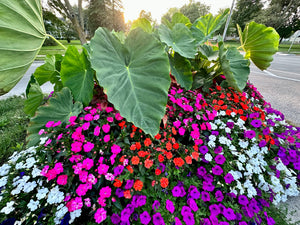
HOW TO USE
Colocasia’s bold leaves and upright habit make it a striking addition to a variety of garden settings. Whether you're crafting a lush tropical retreat or want a standout plant in a container, Colocasia delivers dramatic flair:
- Tropical Borders: Pair with canna lilies, bananas, or hibiscus for a jungle-inspired look.
- Water Gardens: Use along pond edges or in boggy areas; some varieties thrive with roots in standing water.
- Containers: Plant in large pots for patios or entryways. Mix with trailing plants like sweet potato vine or caladium.
- Focal Points: Let varieties like Colocasia 'Thailand Giant' or 'Royal Hawaiian Waikiki' serve as towering focal points.
- Indoor Statement Plants: Smaller cultivars can be grown indoors in bright, indirect light with consistent humidity.
Colocasia pairs beautifully with other moisture-loving plants such as ferns, impatiens, coleus, and grasses for a layered, textural display.
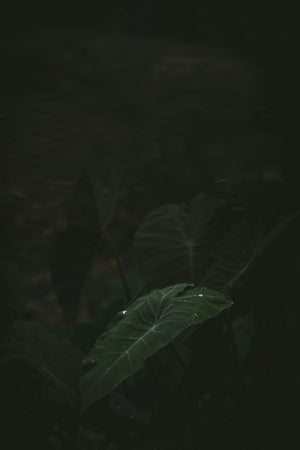
Common Questions
- Are Colocasia and Alocasia the same? No. Though both are called elephant ears, Colocasia and Alocasia differ in leaf shape, orientation, and growing preferences.
- Are all Colocasia edible? No. Only select varieties of Colocasia esculenta are cultivated for edible corms. Always consult reliable sources before consuming.
- Are Colocasia toxic to dogs? Yes, all parts of the plant contain calcium oxalate crystals and are toxic to dogs if ingested.
- Are Colocasia toxic to cats? Yes, Colocasia is also toxic to cats and can cause irritation and digestive distress.
- Are elephant ears Colocasia or Alocasia? Both. The term "elephant ears" refers to multiple genera including Colocasia, Alocasia, and Xanthosoma.
- Can Colocasia be grown indoors? Yes, with sufficient light, humidity, and warmth, Colocasia can be a dramatic houseplant.
- Do Colocasia like full sun? Yes, especially darker-leaved varieties. Others may tolerate part shade, particularly in hot climates.
Conclusion
Colocasia is an essential plant for anyone seeking dramatic, tropical flair in their garden or home. With varieties like Colocasia 'Mojito', 'Royal Hawaiian White Lava', and 'Thailand Giant', there’s a bold and beautiful selection for every space. Whether used as a centerpiece in a patio pot, a moisture-loving specimen at the edge of a pond, or a lush accent in a shade garden, Colocasia transforms your landscape into a tropical paradise.
The Colocasia Collection
Sold Out
Sold Out
Sold Out
Sold Out
Sold Out

